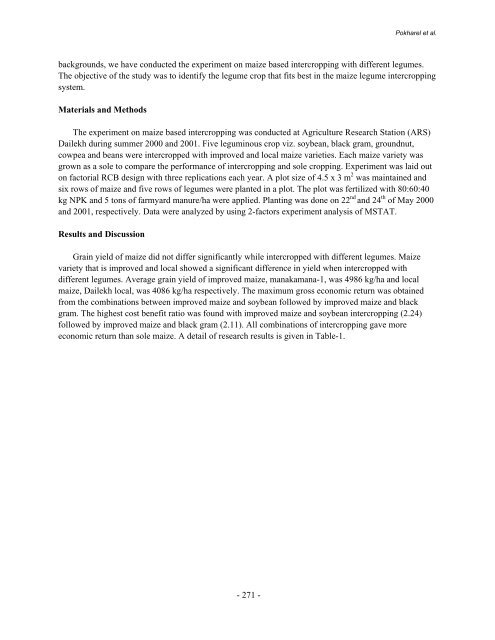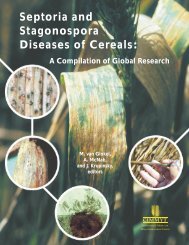Section 3 (Crop Management)
Section 3 (Crop Management)
Section 3 (Crop Management)
Create successful ePaper yourself
Turn your PDF publications into a flip-book with our unique Google optimized e-Paper software.
Pokharel et al.<br />
backgrounds, we have conducted the experiment on maize based intercropping with different legumes.<br />
The objective of the study was to identify the legume crop that fits best in the maize legume intercropping<br />
system.<br />
Materials and Methods<br />
The experiment on maize based intercropping was conducted at Agriculture Research Station (ARS)<br />
Dailekh during summer 2000 and 2001. Five leguminous crop viz. soybean, black gram, groundnut,<br />
cowpea and beans were intercropped with improved and local maize varieties. Each maize variety was<br />
grown as a sole to compare the performance of intercropping and sole cropping. Experiment was laid out<br />
on factorial RCB design with three replications each year. A plot size of 4.5 x 3 m 2 was maintained and<br />
six rows of maize and five rows of legumes were planted in a plot. The plot was fertilized with 80:60:40<br />
kg NPK and 5 tons of farmyard manure/ha were applied. Planting was done on 22 nd and 24 th of May 2000<br />
and 2001, respectively. Data were analyzed by using 2-factors experiment analysis of MSTAT.<br />
Results and Discussion<br />
Grain yield of maize did not differ significantly while intercropped with different legumes. Maize<br />
variety that is improved and local showed a significant difference in yield when intercropped with<br />
different legumes. Average grain yield of improved maize, manakamana-1, was 4986 kg/ha and local<br />
maize, Dailekh local, was 4086 kg/ha respectively. The maximum gross economic return was obtained<br />
from the combinations between improved maize and soybean followed by improved maize and black<br />
gram. The highest cost benefit ratio was found with improved maize and soybean intercropping (2.24)<br />
followed by improved maize and black gram (2.11). All combinations of intercropping gave more<br />
economic return than sole maize. A detail of research results is given in Table-1.<br />
- 271 -









